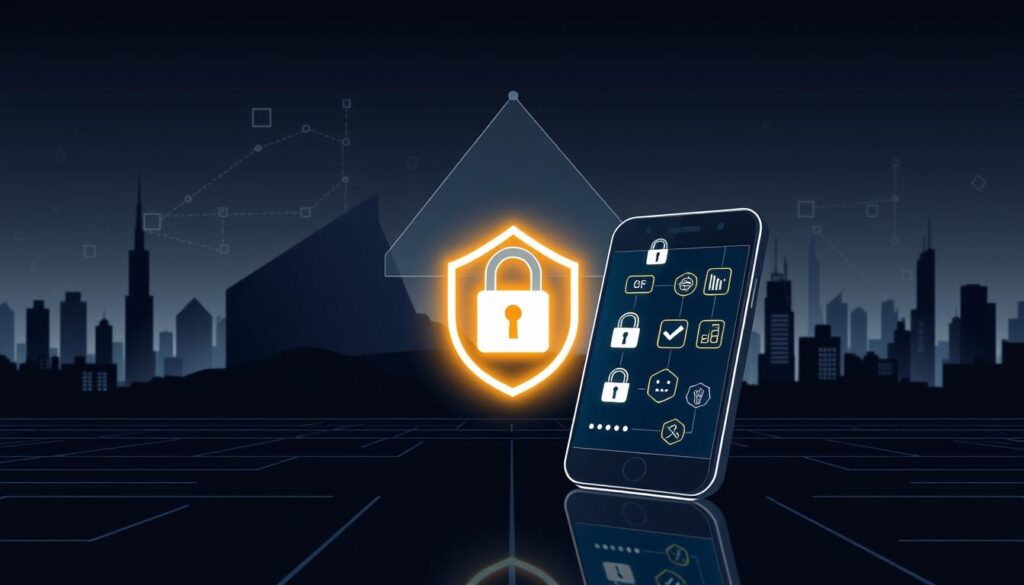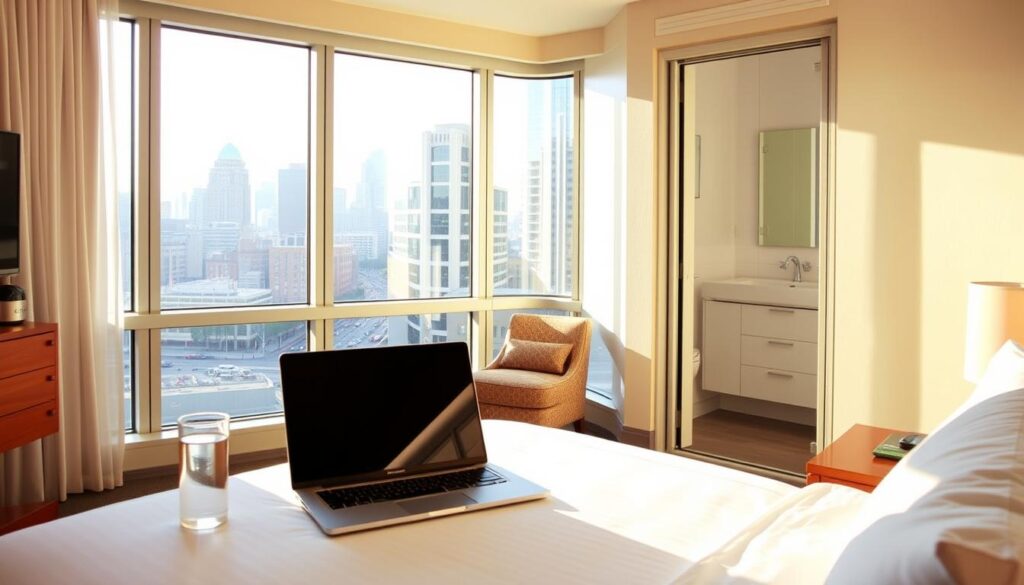Going on solo travel as a woman can change your life. It brings freedom and personal growth. But, it also has its challenges, especially when it comes to safety.
This guide is here to help women travel safely. It covers everything from the right mindset to practical safety tips.
Key Takeaways
- Understand the mindset required for solo travel
- Learn practical safety tips for solo female travelers
- Discover how to build confidence while traveling alone
- Explore the world with a newfound sense of freedom
- Stay safe and enjoy your solo travel experience
The Mindset of a Confident Solo Female Traveler
Starting your journey as a confident solo female traveler means facing and beating your fears. It’s about building a mindset ready for solo travel’s challenges.
Overcoming Fear and Anxiety
Many solo female travelers feel fear and anxiety. But, you can lessen these by preparing well and knowing your destination. Learning about the local culture and safety can help a lot.
Developing Situational Awareness
Being aware of your surroundings is key for solo travelers. It means knowing your environment and spotting potential dangers. This skill grows with experience and staying updated on local news.
Trusting Your Intuition
Listening to your gut is crucial for solo female travelers. If something feels wrong, trust your instincts and act. This means spotting danger signs and following your gut.
Recognizing Warning Signs
Warning signs can be small, like a bad feeling, or big, like odd behavior. Spotting these signs is vital for your safety.
When to Act on Your Gut Feelings
It’s just as important to know when to follow your intuition. If you feel scared or sense danger, it’s safer to leave the situation.
| Mindset Aspect | Description | Benefit |
|---|---|---|
| Overcoming Fear | Preparation and research | Reduced anxiety |
| Situational Awareness | Being mindful of surroundings | Increased safety |
| Trusting Intuition | Listening to gut feelings | Avoiding potential dangers |
Essential Solo Female Travel Safety Principles
As a solo female traveler, it’s key to follow important safety rules. These rules help you feel safe and confident on your journey. They also make it easier to explore new places.
Risk Assessment Fundamentals
First, do a detailed risk assessment. This means looking into your destination’s dangers, like natural disasters or social issues. Knowing the local situation helps lower your risk.
Balancing Adventure with Caution
Traveling is about adventure, but safety is also crucial. Be ready for new things but don’t take too many risks. Listen to your gut; if something feels off, it’s okay to leave.
Creating Boundaries and Enforcing Them
Setting and keeping personal boundaries is essential. This means knowing your space and what you’re comfortable with. Speak up clearly to keep your boundaries respected.
Polite but Firm Communication Techniques
It’s possible to say no without being rude. Use a firm but polite tone to express your needs. This skill helps you handle tricky situations.
Handling Unwanted Attention
Unfortunately, some solo female travelers face unwanted attention. Stay calm, don’t engage, and seek help if needed. These steps can help you handle such situations.
| Safety Principle | Description | Benefit |
|---|---|---|
| Risk Assessment | Researching destination risks | Reduced exposure to danger |
| Boundary Setting | Establishing personal limits | Enhanced personal safety |
| Effective Communication | Using polite but firm techniques | Better boundary enforcement |
Pre-Trip Research: Your Safety Foundation
Having a well-planned travel itinerary is key to a safe and enjoyable solo trip. As a solo female traveler, knowing your destination well is crucial. It ensures your safety and enhances your travel experience.
Researching Destination Safety Profiles
Before you book your trip, it’s vital to check the safety of your destination. Look into crime rates, conflict areas, and travel advisories from your government. The U.S. Department of State’s Travel Advisory page is a great resource for this.
Knowing the local safety scene helps you make smart travel choices. This includes picking safe places to stay and planning activities that are low-risk.
Understanding Local Laws and Cultural Norms
It’s important to learn about local laws and customs to avoid any trouble. By researching these, you’ll know what’s considered polite and what to avoid. This way, you can respect the local culture and stay out of trouble.
“When traveling, it’s not just about seeing new places, but also about understanding and respecting the local culture.” –
Identifying Safe Neighborhoods and Areas to Avoid
Finding out which neighborhoods are safe and which to avoid is crucial. This lets you explore confidently, knowing you’re in secure areas. Use online forums, travel blogs, and local guides to get this info.
Reliable Resources for Safety Information
- Government travel advisory websites
- Travel blogs and forums
- Local guides and tourism websites
- Social media groups for travelers
By using these resources, solo female travelers can prepare for a safe and fun trip.
Essential Safety Gear Every Solo Female Traveler Should Pack
The right safety equipment can greatly improve the safety and confidence of solo female travelers. It’s important to think about what safety gear to pack when preparing for a trip.
Personal Safety Devices
Personal safety devices are key for solo female travelers. Items like pepper spray and personal alarms can scare off threats and add security.
Secure Luggage Solutions
Keeping your luggage safe is also crucial. Using anti-theft bags and locking luggage helps prevent theft and tampering. This ensures your belongings stay safe during your trip.
Emergency Communication Tools
Having the right tools for emergencies is vital. This includes portable Wi-Fi hotspots and satellite phones. They help you stay connected, even in remote areas.
Tech vs. Non-Tech Safety Solutions
Choosing between tech and non-tech safety solutions depends on your trip and preferences. Tech devices offer advanced features. But, non-tech options like whistles and personal safety cards can be just as effective.
Safe solo travel comes down to being prepared. This means having the right safety gear, like personal safety devices, secure luggage, or emergency communication tools.
Physical Self-Defense Training for Women Travelers
Teaching solo female travelers self-defense is key to their safety. It boosts their confidence and awareness. This makes them ready for any danger.
Basic Self-Defense Techniques
Basic self-defense is simple and effective. It targets weak spots like the eyes and groin. Learning these techniques helps women defend themselves.
Recommended Training Programs
Many self-defense programs are made for women. Krav Maga and Radical Self-Defense are top choices. They teach physical skills and how to stay safe.
De-escalation Strategies
De-escalation is key to avoiding fights. It includes talking firmly and knowing how to leave. De-escalation is often the best defense, stopping violence before it starts.
Creating Distance and Safe Exits
Keeping distance from threats is important. Use steps back, turns, or objects to create space. Knowing safe ways out is also crucial.
Using Your Voice as a Weapon
Shouting loudly can scare off attackers. Use clear, firm commands to draw attention. A loud, confident voice can help avoid danger.
Combining physical skills with de-escalation makes travel safer. Self-defense training is a smart move for a secure trip.
Digital Security: Protecting Your Data and Identity Abroad
In today’s digital world, keeping your online presence safe is as crucial as protecting your body. Solo female travelers need to watch their digital steps to stay safe.
Securing Your Devices
Protecting your devices is key to avoiding cyber dangers. Use strong, unique passwords for all accounts. Make sure your operating system and apps are current. Think about using trusted security software to fight off malware.
Safe Social Media Practices While Traveling
Be careful with what you post on social media when you’re away. Don’t share where you are or your plans in real-time. Use privacy settings to limit who sees your posts and info.

Using VPNs and Secure Networks
A Virtual Private Network (VPN) makes your internet use safer, especially on public Wi-Fi. Always turn on a VPN when you’re online with sensitive info.
Managing Location Sharing Settings
Check your device’s location sharing settings to prevent unwanted location sharing. Turn off location services for apps that don’t need them.
| Digital Security Tip | Description |
|---|---|
| Use Strong Passwords | Unique passwords for all accounts |
| Keep Software Updated | Regularly update your OS and apps |
| Use a VPN | Encrypt your internet connection |
By sticking to these digital security tips, solo female travelers can greatly lower their risk of cyber attacks.
Transportation Safety Strategies for Solo Female Travelers
For solo female travelers, knowing how to stay safe on the move is crucial. Getting around is a big part of travel. It needs careful planning to keep you safe.
Navigating Public Transportation Safely
Public transport is a good way to see places, but you must be careful. Learning the safest paths and the local transport system helps. This way, you can avoid danger.
- Research local transportation options and their safety records.
- Avoid traveling alone in isolated areas or at night if possible.
- Keep your belongings secure and be mindful of your surroundings.
Rideshare and Taxi Safety Tips
When you use rideshare or taxi, check the driver’s ID first. Also, tell a friend or family member where you’re going. This makes you safer.
- Always check the driver’s ID and vehicle details before getting in.
- Use reputable rideshare apps and avoid hailing taxis on the street.
- Share your trip details with a trusted contact.
Safe Driving Practices in Foreign Countries
If you like to drive, knowing the local rules is key. It’s important to understand the driving laws and customs of the place you’re visiting.
Arrival and Departure Planning
Plan your arrival and departure ahead of time. Think about the safety of your place to stay and how you’ll get to and from the airport or station.
Night Transportation Considerations
Traveling at night? Stick to well-lit, busy areas. Also, choose reliable transport services.
Secure Accommodation Selection and Safety Practices
Your safety in your accommodation is key when traveling alone. It’s important to choose a place that is both secure and safe.
Vetting Hotels, Hostels, and Vacation Rentals
When picking a place to stay, do your homework. Look at more than just reviews. Think about location and security too. Make sure the area is safe and has good lighting, especially at night.
Use online tools and travel forums to learn more. Check if the place has a 24-hour front desk, secure entry, and safes in rooms.

Room Safety Protocols
After you arrive, learn about room safety. Know where the emergency exits are. Always lock your room door.
Keep valuables in the hotel safe. You might also want a portable door lock for extra safety. Make sure windows and balconies are locked, especially if you’re high up.
Building Rapport with Staff and Fellow Travelers
Getting to know hotel staff and other travelers can help. It adds an extra layer of support. Introduce yourself and ask for help or advice when you need it.
Door and Window Security Techniques
Here are some tips for keeping doors and windows safe:
- Use a doorstop alarm for extra security.
- Always check that doors and windows are locked when you’re inside.
- Think about using a portable door lock.
| Security Measure | Description | Benefit |
|---|---|---|
| In-room Safe | Store valuables securely. | Protects important documents and items. |
| 24-hour Front Desk | Assistance available at all times. | Provides immediate help in case of an emergency. |
| Secure Entry Systems | Controlled access to the building. | Reduces the risk of unauthorized entry. |
Cultural Intelligence: Navigating Different Environments
As a solo female traveler, it’s key to develop cultural intelligence. This skill helps you understand and respect local customs. It makes your travel safer and more enjoyable.
Appropriate Dress and Behavior
Dressing right is a big part of cultural intelligence. Always research the dress code for your destination. In conservative places, covering your shoulders and knees shows respect. Knowing local dress norms helps you avoid unwanted attention and fit in.
Navigating Gender Expectations
Different cultures have different views on gender. Being aware of these can make social interactions smoother. For example, in some places, women are expected to be more reserved. Knowing these expectations helps you avoid offense and have a better trip.
Language Basics for Safety and Respect
Learning basic phrases in the local language is very helpful. It shows respect and helps in emergencies.
Blending In vs. Standing Out
Whether to blend in or stand out depends on you and the culture. Blending in can keep you safe, but standing out can be positive if you’re looking to meet new people.
| Cultural Aspect | Blending In | Standing Out |
|---|---|---|
| Dress Code | Conservative dressing | Expressive, culturally inspired attire |
| Gender Expectations | Respecting local gender norms | Embracing personal identity |
| Language | Using local phrases respectfully | Engaging with locals through language |
Emergency Preparedness and Crisis Management
Being ready for emergencies is crucial when traveling alone as a woman. Even with the best plans, unexpected situations can happen. Being prepared can greatly affect how you manage them.
Creating an Emergency Action Plan
Start by making a detailed emergency plan. This plan should include:
- Contact information for local emergency services
- Details of your travel insurance provider
- Embassy or consulate contact details
- A list of important medications and medical conditions
Important Contacts and Resources
Having the right contacts and resources can save your life. Make sure you have:
- The contact information for your country’s embassy or consulate
- A list of emergency contact numbers, including your emergency services number
- Details of your travel insurance, including the policy number and claims contact
Handling Medical Emergencies Abroad
Medical emergencies can be tough when you’re abroad. It’s important to know how to use local healthcare systems and find the right medical care.
Embassy and Consulate Services
If you face a serious medical emergency, your embassy or consulate can help. They can assist in contacting family and provide info on local medical facilities.
Insurance and Emergency Evacuation
Having the right travel insurance is key. It should cover medical emergencies and evacuations. Know what your policy covers and how to get help in emergencies.
Key Takeaways:
- Create a comprehensive emergency action plan before you travel
- Keep important contacts and resources handy
- Understand how to handle medical emergencies, including the role of embassy services and insurance coverage
Conclusion: Empowering Your Journey as a Solo Female Traveler
Starting your solo female travel journey? Remember, confidence and empowerment are key. By using the safety tips from this guide, you’ll feel free and confident as you explore.
Being informed and prepared is vital. Trust your gut and stay alert to handle surprises. With the right mindset and tools, you can make your travel dreams come true, safely and with joy.
Building travel confidence is about taking small steps. Research places, learn about local customs, and stay in touch with family. Each step moves you closer to your travel dreams. Solo female travel is about personal growth and the amazing experiences you have along the way.
FAQ
What are the most important safety tips for solo female travelers?
Solo female travelers should know their surroundings well. Trust your gut and be ready with safety gear. Also, learn about your destination.
How can I research my destination to ensure it’s safe for solo female travel?
To research a destination, look into local safety and laws. Get to know the culture and safe areas. Avoid dangerous spots.
What safety gear should I pack as a solo female traveler?
Pack personal safety items like pepper spray or alarms. Bring secure luggage and tools for emergencies, like Wi-Fi hotspots or satellite phones.
How can I stay safe while using public transportation as a solo female traveler?
Stay safe by knowing the best routes and times. Be alert and check drivers’ IDs in rideshare or taxis.
What are some tips for choosing secure accommodations as a solo female traveler?
Choose safe places by checking location, security, and reviews. Know the safety rules in your room.
How can I protect my digital identity and data while traveling solo?
Keep devices safe with strong passwords and VPNs. Be careful on social media and manage where you share your location.
What should I do in case of a medical emergency while traveling abroad?
In a medical emergency, find local care and understand healthcare systems. Have the right insurance, including for emergencies.
How can I navigate different cultural environments respectfully and safely as a solo female traveler?
Respect cultures by dressing right and knowing gender norms. Learn basic language to interact with locals.
What are some strategies for dealing with unwanted attention while traveling solo?
Handle unwanted attention by setting clear boundaries. Use polite but firm words. Know how to calm tense situations.
How can I prepare for emergencies and manage crises effectively while traveling solo?
Prepare for emergencies with an action plan and important contacts. Know embassy services and have the right insurance.

